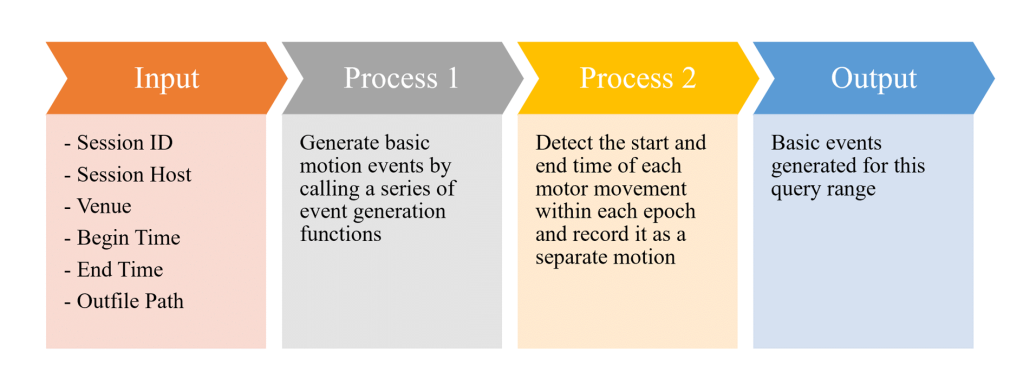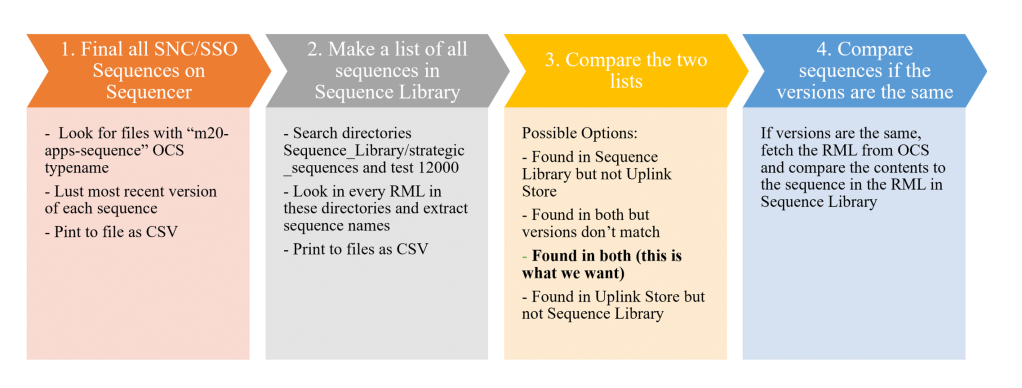The ignition of flammable atmospheres due to a hot surface can cause industrial accidents. We investigate the constraints necessary to create an electrically heated hotspot capable of igniting n-hexane and air mixtures. The temperature profile of an electrically heated stainless steel disk (Ø 50.8 mm) was studied, with the requirement of reaching ignition temperatures (~1100K) at the hotspot. We utilized Abaqus/CAE to build thermal models of the disk and conduct a design study to determine parameters for the experiment. Based on these results, we developed an experimental setup in SolidWorks, and had the parts machined. We then assembled the experiment and passed various currents through the disk, measured the temperature primarily at the center of the disk over time at these various currents, and compared these results to those found in Abaqus. The results show that it is possible for a stainless steel disk of this size to reach ignition temperatures and cause ignition of a hydrogen-air mixture.
Author: Athena Kolli
California Institute of Technology
Mentors: Joseph Shepherd and Donner Schoeffler
Explosion Dynamics Laboratory, California Institute of Technology
Editor: Stephanie Chen
Introduction
Accidental ignition of a flammable atmosphere due to hot metal surfaces is a significant risk in industrial settings. Ignition in these environments can occur when the flammable gas is exposed to a metal surface heated to sufficiently high temperatures, which we predict to be around 1000 to 1100 K [1]. However, the conditions that lead to ignition are also likely dependent on the geometry of the heated surface, size of the region that reaches ignition temperatures (called the hotspot), the length of time that the hotspot is at ignition temperature, and other factors.
In previous years, the Explosion Dynamics Laboratory (EDL), has explored the conditions necessary for ignition of many different test articles including moving spheres, glow plugs, and horizontal cylinders. The most recent work done in thermal ignition has been in researching ignition conditions of electrically heated vertical stainless steel cylinders of various dimensions. As stated above, it was found that for these vertical cylinders, ignition of n-hexane mixtures occurred between 1000 and 1100 K [1]. However, these results may be characteristic of vertical cylinders and other previously explored geometries, so the next step in this line of research is to choose a new geometry with unique fluid mechanics for the test article, and see under which conditions ignition occurs. We decided to work with hotspots because they produce unique fluid mechanics when compared to all work previously done in the EDL, and also because they are of interest to the aerospace industry.
The purpose of the present work is to design and fabricate the test article for which future experiments investigating the thermal ignition of a hotspot can be performed. The goal is to develop and understand the dimensional and current requirements of a 50.8 mm diameter stainless steel disk and accompanying assembly capable of reaching ignition temperatures at the hotspot. We were motivated to develop a hotspot of this size because hotspots of this size regime are relevant to the interests of our funding agency, the Boeing Company.
The challenges involved in this project stem from the axisymmetric nature of the hotspot. Because the current is carried through the disk along the radial direction, the resistance and current vary along this path. As a result, elementary analytic heat transfer techniques cannot be used.
The three modes by which heat is transferred are conduction, convection, and radiation. In this project, we account for conduction and radiation, while convective effects are negligible. Heat conduction can be defined as the energy transfer within a single substance, due to a temperature gradient within the substance. In the case of the disk, while current is passed through its center, its outer edge will remain relatively cooler, and the heat will conduct in a radial direction. Convection is the transfer of heat due to the movement of a fluid caused by the tendency for hotter, and therefore less dense, materials to rise. In this case, convective effects are considered negligible because we are dealing with high temperatures, and convection is proportional to the surface temperature T while radiation is proportional to T4 [2]. Radiation is defined as the emission of energy as electromagnetic waves from a hotter body to its cooler surroundings. All objects above absolute zero emit some thermal radiation, but in our work, we focus on the heat lost from the surface of the disk due to radiation. Together, these two modes of heat transfer account for almost all of the energy being exchanged in the system.
In this project, we heat the disk by passing an electric current through it, causing resistive heating, also known as Joule heating. Joule’s law states that the power produced by Joule heating is directly proportional to the product of the conductor’s resistance and the current squared:
The complication in this case arises when we consider the resistance of the disk, along the direction in which current is flowing. Resistance is defined by the following equation:
Where [Ω-m] is the resistivity,
[m] is the length, and
[m2] is the cross sectional area. As the current travels through the disk in the radial direction, the cross sectional area is changing, and thus these calculations cannot be done easily by hand. Consequently, we utilized a computer aided engineering (CAE) software, called Abaqus, to make these calculations.
Finally, we conducted a design study for the disk and assembly. In this study, we went through an incremental design process during which we altered the dimensions and materials of parts of the cross section to create a continuously decreasing radial temperature profile.
Methods
Validation of Abaqus/CAE
Abaqus/CAE was chosen to determine the dimensions and current for the experimental set up because this software offers an axisymmetric mode for solving heat transfer problems, allowing us to easily model the disk and make changes to its dimensions in order to achieve the desired hotspot temperature. The axisymmetric mode also allowed for our models to have a high level of detail while keeping the total number of nodes low. Additionally, Abaqus allowed us to use temperature dependent data for values such as thermal and electrical conductivity, and specific heat of the materials. In a quick design study, we looked at the results of the one dimensional resistive heating of a rectangular sheet of stainless steel and found that using temperature dependent data for thermal and electrical conductivity and specific heat results in temperatures as much as 70 K greater than those resulting from using constant data for these values (Figure 1) [3][4]. Thus, this study serves to show that using the axisymmetric mode in Abaqus to choose dimensions and current level for our test article and assembly provides us with quicker and more accurate results.

Next, we validated Abaqus for the coupled thermal electric mode that we planned to use by testing it against known solutions. We did this by comparing Python scripts with the correct known solutions to a model in Abaqus with identical initial conditions, boundary conditions and material properties.
The first case we considered is a zero dimensional resistive heating case of a rectangular sheet of metal, in which current is applied through the ends, while the sides and top and bottom faces are electrically insulated (Figure 2A). Additionally, the top and bottom faces radiate thermal energy, while the ends and sides are thermally insulated. The Python script uses the energy balance equations for the block and models the change in energy over time by considering the input of energy due to the joule heating and the energy loss due to radiation. The ordinary differential equation solver from the scipy package is the numerical method used to integrate the differential equation for temperature as a function of time.
We then modeled a rectangular metal sheet of the equivalent dimensions and inputted the same material values, boundary conditions, and current in Abaqus. We compared the temperature values over time in the following plot, and saw that the Abaqus model result yields almost exactly the same results as the Python script.


The next case that we verified was the one dimensional resistive heating of a rectangular sheet of metal (Figure 3A). The sheet has a fixed temperature on its ends, is thermally insulated on its sides, and radiates thermal energy from its top and bottom. The current travels through the ends of the sheet, while the sides and top and bottom are electrically insulated. In this case, we must consider conduction along the direction of the current, and thus need to discretize the sheet into rectangular volumes such that temperature is now a function of time and space.
We then use Fourier’s Law of Conduction and assume that the properties included are all temperature independent. We then integrate the partial differential equation for temperature using the method of lines and the lsoda time integrator with backward-difference solver bdf for stability, and analytically find the steady state solution.


The final case we checked was the one directional resistive heating of a metal disk (Figure 4A). In this case, the analogous Abaqus model was created as an axisymmetric solid, so when working with the model, we only specified conditions on the rectangle outlined in yellow in the below image. The outer radius of the disk was fixed at 300K, while the top and bottom sides of the disk radiate thermal energy. The current travels radially through the disk, while the top and bottom of the disk are electrically insulated. The Python script utilizes similar methods as in the case of one dimensional resistive heating of a rectangular sheet of metal.


In each case, we then plotted the solutions from Abaqus and the Python scripts and showed that they are reasonably close, thus verifying that Abaqus would provide accurate results for coupled thermal electric problems (Figures 2B, 3B, 4B).
Abaqus/CAE Design Study
The first model we analyzed was of a single stainless steel piece with the current passed into the bottom face of the thick stem (Figure 5). We chose to create these models using the axisymmetric mode, as the disk and flange are symmetric around the central axis. There are two problems with this design. Firstly, most of the heat is dissipated in the stem, and secondly, the hottest part of the piece is at the base of the stem. In contrast, we want the hottest part of the piece to be at the center of the disk to create the hotspot.

We then came up with a design in which a copper rod would grip the thinner stem of the stainless steel piece, in order to combat heat loss up the stem (Figure 6A). This, however, introduced the problem of the heat conducting away from the stainless steel disk where the copper was in contact with the disk. This caused a temperature profile with a peak temperature that was at some radius away from the center, rather than creating a central hotspot (Figure 6B).


To combat this issue, we replaced the top part of the copper piece with stainless steel, and shortened this piece such that it was not in contact with the stainless steel disk, greatly reducing conductive losses without increasing heat dissipation in the stem (Figure 7A). We proceeded with this technique but switched from rods to bars in the computer-aided design (CAD) phase in order to achieve better clamping on the small stainless steel stem, to reduce contact resistance. The critical dimension in this assembly is the cross sectional area of the bars/rods which determines the resistance of the pieces. Because we kept the cross sectional area consistent in the switch from rods to bars, we were able to continue using the axisymmetric mode in Abaqus to model the assembly.
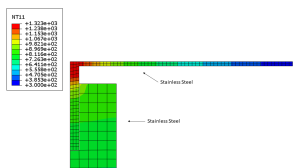

Testing Set Up
The disk and bars that hold the stem are made of 303 stainless steel, and the other bars are made of 101 Copper. The flange is made of 6061 Aluminum, and finally the cable is 4/0 battery wire. Once the parts were assembled, thermocouples were welded to the center of and along the radius of the disk in order to take temperature readings of these spots over time.

Results
Design choices for the disk thickness and method of passing current through the disk were determined based on models created in Abaqus/CAE, an engineering software with the capability of doing thermal analysis of mechanical components and assemblies. The final disk thickness was chosen to be 0.508 mm, and the disk and assembly are shown below.
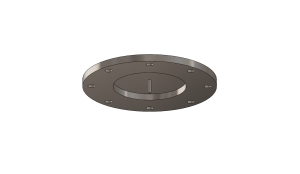

The parts were assembled and connected to the power supply, passing currents between 80 A and 120 A through the assembly. To measure the temperature, we spot-welded a thermocouple at the center of the disk, and recorded the temperature data over time. The temperature data at a few other points on the disk were measured using the same method, to get an idea of the temperature profile of the disk (Figure 14). These points were at the center, a 5.5 mm radius, and a 23.5 mm radius at 110 A (Figure 13).



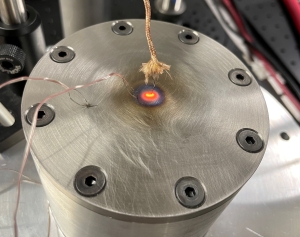

Figure 12: View of disk with thermocouples welded on at various distances from the center. The thermocouples were welded at the center, 5.5 mm, and 23.5 mm, and all measured temperature data over time.
Figure 13: Temperature vs. Time at various distances from the center for 110 A. This data suggests that as temperature was measured further from the center, the measured temperature decreased.
Discussion
After comparing Abaqus models of the assembly with nominal dimensions to the results of the experiment, we see that the experiments yield much higher temperatures than the models at the same currents.
| Current Input | Experimental Maximum Temperature at Center | Predicted Maximum Temperature at Center | Additional Amps Required to Achieve Experimental Temperature in Abaqus |
| 80 A | 777 K | 588 K | 28 A |
| 120 A | 1247 K | 871 K | 48 A |

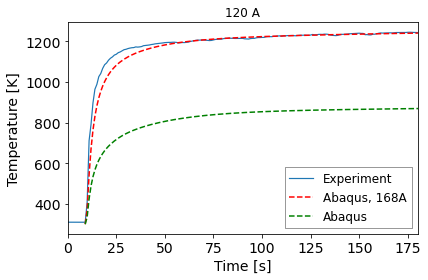
We include the results of the highest and lowest currents tested in the table above. For example, with 80 A, the lowest current that we tested, we recorded a maximum temperature of 777 K after running current for about three minutes, which is 189 K higher than what the Abaqus simulations predicted (Figure 14A). In order to match the experimental temperature that 80 A is producing, we must pass an additional 28 A in the Abaqus model.
One source of discrepancy in these results was the inconsistency in the disk thickness, as measured by an imperial micrometer (0.0001-0.001 inches). Due to the extremely thin nature of the disk and the necessity for the disk and stem to be machined out of the same piece of material, the resulting disk was of uneven thickness, and was at points significantly less than the desired thickness, ranging from 0.244 mm to 0.518 mm.

Another likely source for this discrepancy was the very thin crack that was found around the region of the stem at the top of the disk (Figure 15). Both of these inconsistencies with the nominal design likely contributed to the resulting higher temperatures as they caused a decrease in the cross sectional area of the current path, thus increasing resistive heating.
However, in order to prove that ignition due to a disk of about these dimensions in this setup was possible, we cut a piece of 0.305 mm thick stainless steel shim and spot welded it to a steel rod of the same dimensions as the stem in the initial design (Figure 16).
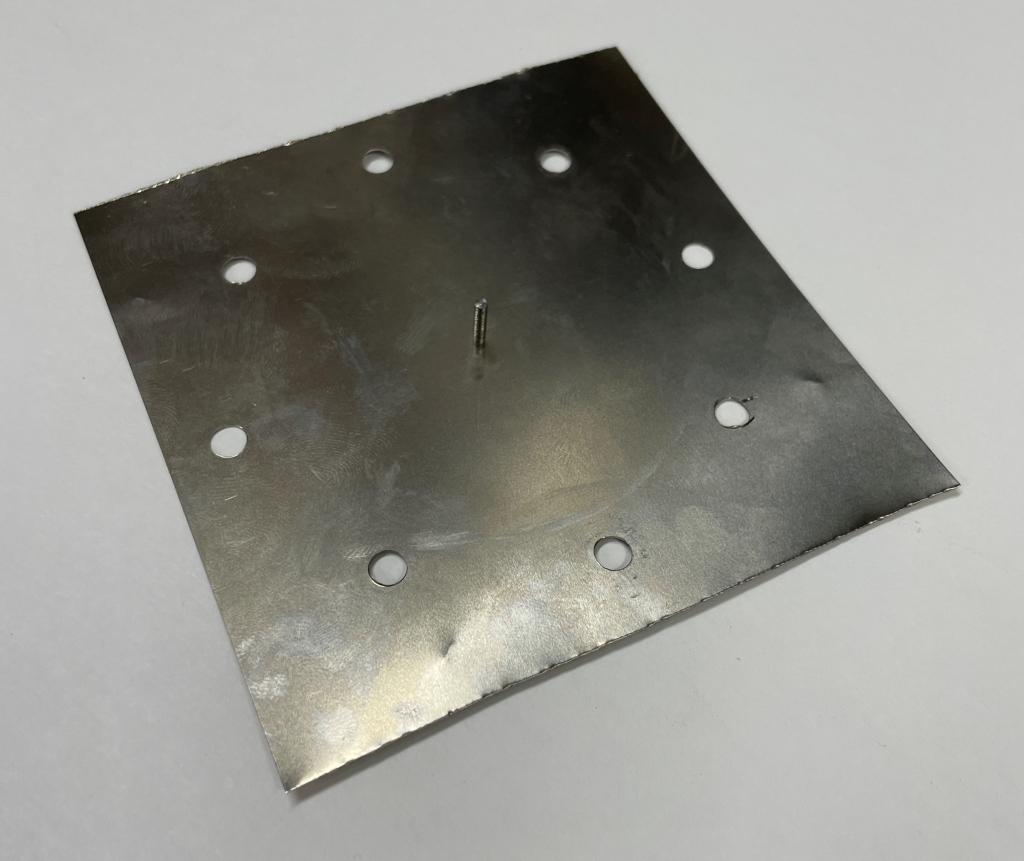
We were able to achieve ignition of a hydrogen-air mixture (29.6% H2 70.4% air) at 130 A. We modeled this case using the same methods used for the original disk, and Abaqus predicted that the temperature at the hot spot was around 861 K. Although this is a lot lower than expected ignition temperatures, this result supports the data above showing that Abaqus predicted temperatures on the order of a few hundred Kelvin lower than the actual temperature. In this case, the higher temperature in the experiment could be due to radiation from the stem being reabsorbed at the hotspot, resistance from the spot weld that joined the stem to the sheet, or deformation of the sheet increasing the thermal resistance of the test article.
Conclusions
In this work, we designed an electrically heated hot spot and measured the temperature over time at the hot spot and a few other points at various temperatures. With Abaqus, we were able to design a test article that was able to produce ignition temperatures. However, because of the repeated heating and cooling of the test article, the disk experienced deformation and eventually cracked, preventing us from performing an ignition experiment with the original disk. In future work, it will be important to consider the effects of deformation on the disk and the repeatability of the experiments. It may be beneficial to design an easier to manufacture test article so that data can be collected with test articles that have only been used a few times, minimizing the effects of the deformation on the resulting temperature.
Acknowledgments
This research project was made possible by the Caltech SURF Program, Explosion Dynamic Laboratory, and its funding agency, the Boeing Company. I would like to thank my mentor, Dr. Joe Shepherd, for allowing me the opportunity to work in the Explosion Dynamics Laboratory this summer. I would also like to thank my co-mentor Donner Schoeffler for providing me with the knowledge and guidance to be successful in my project. Finally, I would like to thank both Bob and Toni Perpall and the SFP Office for funding and facilitating my SURF this summer, and giving me the opportunity to conduct research as an undergraduate student.
References
- J. Melguizo-Gavilanes, L. R. Boeck, R. Mével, and J. E. Shepherd, “Hot surface ignition of stoichiometric hydrogen-air mixtures,” International Journal of Hydrogen Energy, vol. 42, no. 11, pp. 7393–7403, Mar. 2017, doi: 10.1016/j.ijhydene.2016.05.095.
- John H. Lienhard IV and John H. Lienhard V, A Heat Transfer Textbook, 5th ed. Cambridge, Massachusetts: Phlogiston Press, 2020.
- C. S. Kim, “Thermophysical Properties of Stainless Steels,” Argonne National Laboratory, ANL-75-55, 1975.
- C. Y. Ho and T. K. Chu, “Electrical Resistivity and Thermal Conductivity of Nine Selected AISI Stainless Steels,” American Iron and Steel Institute, CINDAS Report 45, 1977.
- J. Adler, “Ignition of a combustible stagnant gas layer by a circular hot-spot,” null, vol. 3, no. 2, pp. 359–369, Jun. 1999, doi: 10.1088/1364-7830/3/2/309.
- S. Jones and J. Shepherd, “Thermal ignition of n-hexane air mixtures by vertical cylinders,” International Symposium on Hazards, Prevention, and Mitigation of Industrial Hazards, 2020.
- “What is a type K Thermocouple?,” https://www.omega.com/en-us/. https://www.omega.com/en-us/resources/k-type-thermocouples (accessed Sep. 16, 2021).
Further Reading
Thermal ignition of n-hexane of air mixtures by vertical cylinders
Hot surface ignition of stoichiometric hydrogen-air mixtures
Ignition of a combustible stagnant gas layer by a circular hot-spot


